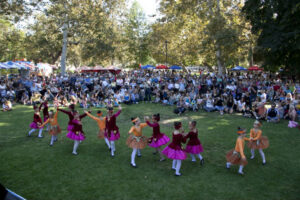Back in LA, and Happy to Be Here

K and I were in LA this weekend visiting four of our grandchildren and their parents. Every time I come here, I have the same thought: Despite everything that’s wrong about LA (high cost of living, high taxes, high crime, and an extra-high degree of Wokeness), the city has so much going for it.
The landscape is beautiful. Mountains in the distance. Foothills at your doorstep, The ocean and the desert less than an hour’s drive away. And the climate is almost ideal. Warm (but rarely hot) in the daytime. Cool (but rarely cold) at night.
When you are in LA, untethered by business meetings and the like, it’s impossible not to feel the tender comfort of its climate or the arresting beauty of the surrounding mountains. And if your reference is NYC or South Florida, as mine is, it’s all the more wonderful.
And there’s much more.
LA is, of course, the entertainment capital of the world. But that’s not what makes it an entertaining city. Rather, it’s the fact that it is a sprawling network of dozens of diverse working-class neighborhoods, each one offering up its food and culture to just about anyone that wants to explore.
And if neighborhood exploration isn’t your thing, LA has the usual city attractions. Big, beautiful parks and big, impressive museums, foodie-restaurant strips, wineries, bike and hiking trails, as well as the Hollywood Hills, Topanga Canyon, Santa Monica, Venice Beach, the Sunset Strip, and, if baseball is your thing, the Dodgers.
For many residents, the best thing about LA is the ability to escape the city. As one said, “To go from sea level and craziness to 8,000 feet and solitude is what keeps me here… and sane.”
That’s what is good and great about LA. What isn’t good is, as I said, the high prices and rising crime. We were in an upscale store yesterday that typified this contradiction. The store was beautifully designed. The product line was all one could want. The service was attentive. But there was what looked like garage door mechanisms on the inside of the plate glass front windows.
“What is that for?” I asked the woman attending us. “It’s to keep people from breaking in at night and clearing out our inventory,” she said.
Some Ethnic Generalizations
We are staying once again in the Glenmark Hotel, which is located in Glendale, a neighborhood of 200,000 people, of which 80,000 are Armenian.

14th Annual Armenian Independence Day festival in Glendale, Sept. 17, 2023
That, for me, is a very good thing. Glendale’s vibe is 60% California and 40% Armenia. What the hell does that mean?
When I’m in Glendale, I don’t feel like I’m in Armenia. (I have never been in Armenia.) I feel like I’m in America. But a better, safer, more civilized America. And that’s because of the Armenian culture. Which is, in all the fundamental aspects I have observed in the half-dozen times I’ve been here, more civilized than the culture that contemporary America has come to embrace.
Glendale reminds me of Baltimore’s “Little Italy” (where I had a commuting apartment in the early 1990s). It felt rich in its native culture and much safer and more civilized than most of the rest of Baltimore, but with all the benefits (and there are some) of being a denizen of the city.
And the Armenian people here remind me of the Polish people, which I wrote about Sept. 12.
They are proud and dignified. They don’t defer to Americans, because they don’t want to see their culture descend to America’s culture. But if you behave with the courtesy of an Armenian, they will treat you with the respect and courtesy they have traditionally given themselves.




